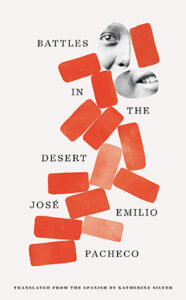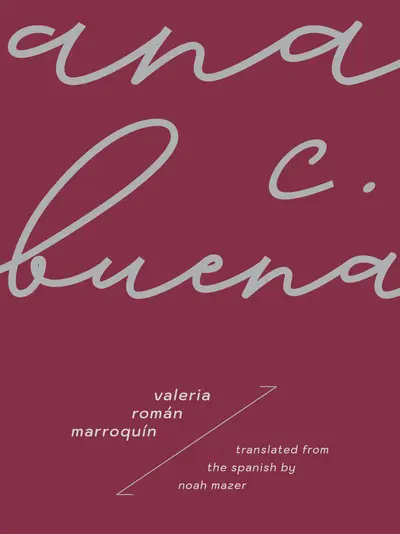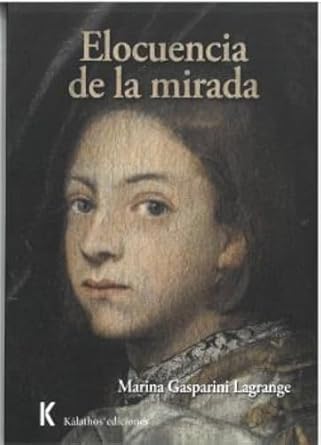Epilogue by Fernanda Melchor. New York: New Directions, 2021. 80 pages.
 Some four decades after its publication in Mexico in 1981, Battles in the Desert continues to be one of the most widely read and celebrated novels in contemporary Mexican literature. There are many reasons for its popularity among readers. Simply reading the excellent prose is enough to confirm the psychological depth of the voice telling the story and the superb imagination of a narrator who quickly makes us privy to the most delicate childhood memories.
Some four decades after its publication in Mexico in 1981, Battles in the Desert continues to be one of the most widely read and celebrated novels in contemporary Mexican literature. There are many reasons for its popularity among readers. Simply reading the excellent prose is enough to confirm the psychological depth of the voice telling the story and the superb imagination of a narrator who quickly makes us privy to the most delicate childhood memories.
Considered a coming-of-age novel or a sentimental education novel—and perhaps the second definition is the most precise—Battles in the Desert tells the story of the childhood of Carlitos, the book’s memorable protagonist, in Mexico City during the years after World War II and the six-year term of President Miguel Alemán (1946-1952). To tell the story, Pacheco uses a first person, autobiographical, confessional narrator to relay the obligatory entry of Carlitos, an eight-year-old child, into an adult world. This occurs after he falls in love with Mariana, the mother of Jim, his best friend from school. However, to clarify, this narrative “I” shifts time and again throughout the story to give voice to the mature Carlos, a subject who is full of memories and nostalgia, and who evokes his romantic odyssey forty years after it occurred.
But unlike that of the innocent Carlitos, Carlos’s story is marked by the scars his childhood and romantic experience left on him. Consequently, the story opens by casting doubt on these faraway years: “I remember—I don’t remember: what year was that?” (9) are the novel’s first words, a phrase that reappears at the end of the book when the protagonist tries to sort out the events marking his childhood and the discovery of his first love.
President Miguel Alemán is a seminal figure during the protagonist’s formative years. Alemán was the first president without a military background to come to power in Mexico after the Mexican Revolution (1910-1920). A member of the Institutional Revolutionary Party (PRI) that governed Mexico for seventy years in the twentieth century, Alemán’s government opened Mexico to investment from US multinationals and led to six years of rampant corruption, which the novel denounces. At the same time, the conflict between Mexican tradition and the forced modernity proposed and imposed by the US presence in Mexican life is a central theme in the story. But, if the PRI’s influence on Carlitos’s early years was a promise of “progress” and entry into an emerging modernity, when the protagonist’s romantic crisis blows up, other social institutions influencing the young man’s personality, such as school, family, the church, and psychotherapy, also reveal falsehoods within their discourses.
Apart from the political portrayals in the novel, the influence of popular culture on Carlitos’s intellectual and affective development is clear. In the 1940s, radio was the dominant form of media. Therefore, the protagonist evokes voices from programs such as “Las aventuras de Carlos Lacroix, Tarzan, The Lone Ranger, La Legión de los Madrugadores… Dr. Lovesick From Her Soul Hospital” (9) because they are ingrained in his memory. Figures from American films also appear, such as Errol Flynn, Rita Hayworth, and Tyrone Power, who increasingly displace the Mexican icons of the period. In addition, the memory of traditional Latin American music is evident in the novel with the frequently mentioned Puerto Rican bolero “Obsession.” Pedro Flores’s song becomes a leitmotiv throughout the novel, as it fully expresses Carlitos’s confused emotional state: “However high the heavens or the skies, / however deep the ocean lies, / Nothing in the world from you will keep, / my love for you so true and deep” (10). In addition to these manifestations of popular culture, we have multiples references to US products that invade the Mexican market. For example, the first cars manufactured after the war (“Packard, Cadillac, Chrysler…”); fast food (“hamburguesas, pyze, danas, jotdogs, ayescreem, margarina, pinutbuter” (11); and, of course, the arrival of novel household appliances, such as washing machines, vacuum cleaners, and blenders, that transform Mexican domestic life. Over time, the force of US culture would greatly alter national traditions; the new model to follow became the “American Way of Life,” which Alemán’s government promoted, with all its paradoxes and contradictions. This aspect is not insignificant because, beyond being a bildungsroman, when read carefully, Pacheco’s novel is a reflection on the economic and social relations between Mexico and the United States, a difficult historical connection that still resonates today.
Battles in the Desert also relays the entire international historical context after World War II in 1945: the beginning of the Cold War, the threat of nuclear war, the formation of Israel in 1948 with the consequent struggle between Arabs and Jews. Additionally, the novel refers to populist movements in Latin America with figures such as General Henríquez Guzmán in Mexico or Juan Domingo Perón in Argentina, two leaders with whom Héctor, the protagonist’s brother, sympathizes. Other topics in the book include the passage of time—a constant preoccupation in Pacheco’s work—and individual and collective memory. Thus, just as the narrator at the beginning of the novel wonders about the year in which his memories are rooted, it isn’t surprising that at the end of the novel, when he recalls Mariana’s death, he says the following with a degree of bitterness: “So ancient, so remote, such an impossible story. But Mariana existed, Jim existed, everything existed that I’ve repeated to myself after such a long time of refusing to confront it. I’ll never know if the suicide was true. I never again saw Rosales or anybody else from that era. They demolished the school, they demolished Mariana’s building, they demolished my house, and they demolished Colonia Roma. That city ended. That country is finished. There is no memory of the Mexico of those years. And nobody cares—who could feel nostalgia for that horror? Everything came to an end the way the songs on the jukebox come to an end. I’ll never know if Mariana is still alive. If she were alive today, she’d be eighty years old” (71).
Fernanda Melchor is right when she affirms in her epilogue that there is deceptive simplicity in the pages of this masterful story, a virtue that Katherine Silver’s excellent translation will now share with an English-language readership.





